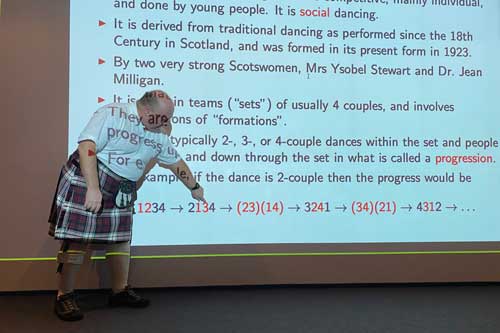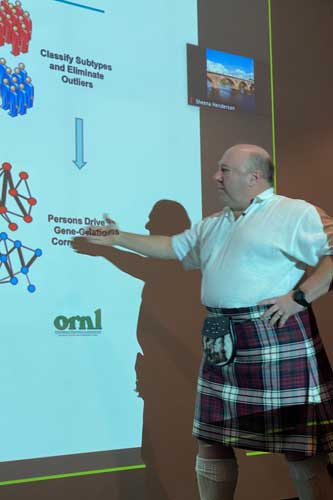Rod gives lots of talks as part of his job as a mathematician. Every now and again he’ll mention Scottish Country Dancing, but this is the first time he’s been specifically asked to give a talk on the relationship between two passions in his life – mathematics and Scottish Country Dancing.
The Hawke’s Bay Branch of the Royal Society Te Apārangi contacted Rod earlier in the year about giving a talk on that specific topic. The original June date had to be postponed due to Covid-19, but the talk did go ahead this week on Thursday 27 August.
You might wonder, how did they know to ask? The answer lies partially in the fact that Rod wore his Dress Macdonald kilt to the 2018 Royal Society Te Apārangi Research Honours dinner where he was awarded the Rutherford medal. The kilt is his default ‘formal wear’ as he does not own a suit!
As is often the case in New Zealand, personal connections also came into play. Ex-VUW colleague and ecologist Charles Daugherty, and his wife Maryanne Horsfield (a past dancer at Johnsonville Club) retired to Havelock North, and came in contact with the Hawke’s Bay branch of the Royal Society. Charles was the natural person to approach Rod on behalf of the branch.
Public lectures are always a bit of a lottery in terms of how many will turn up on the night. But with at least a set of Scottish country dancers arriving even before Rod did (!) the planetarium was packed. Special thanks to the Clive Friday Scottish country dancers who turned out in force.
Rod had planned to live stream on Zoom, and record his talk for those who couldn’t zoom in live. Live streaming was successful, but technological issues meant that alas, his talk did not record.

Read more below to get a flavour of Rod’s talk including links to the Scottish Country Dancing videos he used, or view the full set of lecture slides – the best alternative to the recording that didn’t quite work out.
Kristin Downey
Maths and Scottish Country Dancing
A lecture to the Hawke’s Bay Branch of the Royal Society Te Apārangi 27 August 2020
The Hawke’s Bay Branch of the Royal Society has an interesting history, growing out of the Hawke’s Bay Philosophical Institute established in 1874. It is very active ‘in the advancement and the public understanding of science, technology and the humanities, particularly through the delivery of lectures to members and the general public of Hawke’s Bay.’
The branch has a good relationship with Hawke’s Bay Holt Planetarium and uses it as a venue for some of their public lectures. Organiser Lynne Trafford purposely chose this atmospheric venue for Rod’s talk – he was surrounded by space paraphernalia, with a model spacecraft suspended above his head.

Mathematics
Rod first talked about the mathematics he does, beginning with graph theory and algorithms. He also mentioned some applications of his research by others, using paramaterised complexity – things like genomic analysis of the causes of prostate cancer, and data analysis of otitis media in aboriginal communities. He emphasised that the original research was purely ‘blue skies’ research, with no applications in mind.

Rod then spoke about his new area of research interest, online algorithmics. An online algorithm is one where you have to react to dynamic situations, making decisions without knowing the future. For example a triage nurse must schedule patients as they arrive, without knowing anything about patients who will arrive in the future. (In contrast, an offline situation would be where all appointments are made in advance.)
His research aims to find a general framework to design algorithms to solve these ‘online’ problems. The key aspect of all of this is the visualisation of what is happening to objects as they evolve with time.
So how does this relate to Scottish Country Dancing?
Scottish Country Dancing
For those at the talk not familiar with Scottish Country Dancing, Rod used this video of De’il Amang the Tailors to illustrate an old dance which is loved worldwide, for the choreography and music combination. For Rod, the music is king, and the single most important part of the dance is the interpretation of the music.
When he devises a dance he needs to understand how the interacting agents (in this case people) must behave, so as to enable the phrasing and choreography of the dance. Where should everyone be and when? How can each individual dancer modify their phrasing to enable the dance for themselves and others?
A simple example of this is a right shoulder reel, where each dancer must adjust to the others as they move through space and time. To see clearly how team phrasing works in a dance, look at this video of The Celtic Brooch devised by Hugh Foss (the leader of the team at Bletchley Park which broke the Japanese Enigma code).
Rod enjoys the challenge of constructing new formations for the dances he devises. In this video of his dance My Golden Bear the central figure ‘Corners Pass and Turn in Tandem’ is one of his new formations. All the dancers must work together to enable the figure to succeed.
Aesthetics are also a big consideration for him, he finds both maths and Scottish Country Dancing ‘quite beautiful’.
An example of a beautiful piece of mathematics is Euler’s theorem on plane graphs. Why is it beautiful? It tells us something universal, it is unexpected, and the proof is intuitive, visual and simple. With the stroke of a few lines we see something eternal about all plane graphs.
Everyone has their own idea of what makes a beautiful formation or dance. Rod’s formation the Rose progression has flow, phrasing, visualisation in space and gives a certain ‘feel’ when it is danced. The RSCDS Lyon Branch ‘Ladies 1 team’ demonstrated the Rose beautifully at the 2019 Newcastle festival – watch them dance Library of Birmingham by Kenneth Reid.
Rod’s Summary
For this kind of mathematics we attempt to understand interacting processes as they change with time, and develop algorithms to cope with that.

The creative part is to develop the framework: How to represent things, and the algorithmics: How to make efficient, safe, etc algorithms, and how do I know they are good or maybe the best?
For this kind of dancing we have many agents (people) interacting with time: How to develop an algorithm (a dance), choreography which allows flow through positions.
Both have aesthetics although the mathematics is not usually set to music. A beautiful exception is Dance your PhD by Roni Zohar.
For more information (especially on the maths) view the full set of lecture slides on Rod’s website.

by Rod Downey
27 August 2020
Click here for a short video snippet of Rod in action at his talk Video: Isabel Jackson

